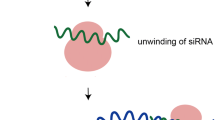Abstract
RNA interference (RNAi) holds considerable promise as a novel therapeutic strategy to silence disease-causing genes not amenable to conventional therapeutics. Since it relies on small interfering RNAs (siRNAs), which are the mediators of RNAi-induced specific mRNA degradation, a major issue is the delivery of therapeutically active siRNAs into the target tissue. In vivo gene silencing with RNAi has been reported using both viral vector delivery and high-pressure, high-volume intravenous (i.v.) injection of synthetic siRNAs. For safety reasons, strategies based on viral vector delivery may be only of limited clinical use. The more desirable approach is to directly deliver active siRNAs. We describe the use of hydrodynamic administration as a technique to deliver naked siRNA constructs into experimental animals as a method of transient gene knockdown. This approach demonstrates that RNAi can be used to silence endogenous genes, involved in the cause of human diseases, with a clinically acceptable formulation and route of administration.
Access this chapter
Tax calculation will be finalised at checkout
Purchases are for personal use only
Similar content being viewed by others
References
Leung, R. K. M., and Whittaker, P. A. (2005) RNA interference: From gene silencing to gene-specific therapeutics. Pharmacol. Ther. 107, 222–239.
Lu, P. Y., Xie, F., and Woodle, M. C. (2005) In vivo application of RNA interference: from functional genomics to therapeutics. Adv. Genet. 54, 117–142.
Paddison, P. J., Silva, J. M., Conklin, D. S., Schlabach, M., Li, M., Aruleba, S., et al. (2004) A resource for large-scale RNA-interference-based screens in mammals. Nature 428, 427–431.
Berns, K., Hijmans, E. M., Mullenders, J., Brummelkamp, T. R., Velds, A., Heimerikx, M., et al. (2004) A large-scale RNAi screen in human cells identifies new components of the p53 pathway. Nature 428, 431–437.
Zender, L., Hutker, S., Liedtke, C., Tillmann, H. L., Zender, S., Mundt, B., et al. (2003) Caspase 8 small interfering RNA prevents acute liver failure in mice. Proc. Natl. Acad. Sci. U.S.A. 100, 7797–7802.
Song, E., Lee, S. K., Wang, J., Ince, N., Ouyang, N., Min, J., et al. (2003) RNA interference targeting Fas protects mice from fulminant hepatitis. Nat. Med. 9, 347–351.
Ying, R. S., Zhu, C., Fan, X. G., Li, N., Tian, X. F., Liu, H. B., et al. (2007) Hepatitis B virus is inhibited by RNA interference in cell culture and in mice. Antiviral Res. 73, 24–30.
Budker, V., Zhang, G., Knechtle, S., and Wolff, J. A. (1996) Naked DNA delivered intraportally expresses efficiently in hepatocytes. Gene Ther. 3, 593–598.
Zhang, G., Budker, V., and Wolff, J. A. (1999) High levels of foreign gene expression in hepatocytes after tail vein injections of naked plasmid DNA. Hum. Gene Ther. 10, 1735–1737.
Maruyama, H., Higuchi, N., Nishikawa, Y., Kameda, S., Iino, N., Kazama, J. J., et al. (2002) High-level expression of naked DNA delivered to rat liver via tail vein injection. J. Gene Med. 4, 333–341.
McCaffrey, A. P., Meuse, L., Pham, T. T., Conklin, D. S., Hannon, G. J., and Kay, M. A. (2002) RNA interference in adult mice. Nature 418, 38–39.
Soutschek, J., Akinc, A., Bramlage, B., Charisse, K., Constien, R., Donoghue, M., et al. (2004) Therapeutic silencing of an endogenous gene by systemic administration of modified siRNAs. Nature 432, 173–178.
Jackson, L. N., Larson, S. D., Silva, S. R., Rychahou, P. G., Chen, L. A., Qiu, S., et al. (2008) PI3K/Akt activation is critical for early hepatic regeneration after partial hepatectomy. Am. J. Physiol. Gastrointest. Liver Physiol. 294, G1401-G1410.
Larson, S. D., Jackson, L. N., Chen, L. A., Rychahou, P. G., and Evers, B. M. (2007) Effectiveness of siRNA uptake in target tissues by various delivery methods. Surgery 142, 262–269.
Watanabe, H., Saito, H., Rychahou, P. G., Uchida, T., and Evers, B. M. (2005) Aging is associated with decreased pancreatic acinar cell regeneration and phosphatidylinositol 3-kinase/Akt activation. Gastroenterology 128, 1391–1404.
Braasch, D. A., Paroo, Z., Constantinescu, A., Ren, G., Цz, O. K., Mason, R. P., et al. (2004) Biodistribution of phosphodiester and phosphorothioate siRNA. Bioorg. Med. Chem. Lett. 14, 1139–1143.
Fenske, D. B., and Cullis, P. R. (2008) Liposomal nanomedicines. Expert Opin. Drug Deliv. 5, 25–44.
Noble, C. O., Kirpotin, D. B., Hayes, M. E., Mamot, C., Hong, K., Park, J. W., et al. (2004) Development of ligand-targeted liposomes for cancer therapy. Expert Opin. Ther. Targets 8, 335–353.
Zimmermann, T. S., Lee, A. C. H., Akinc, A., Bramlage, B., Bumcrot, D., Fedoruk, M. N., et al. (2006) RNAi-mediated gene silencing in non-human primates. Nature 441, 111–114.
Hu-Lieskovan, S., Heidel, J. D., Bartlett, D. W., Davis, M. E., and Triche, T. J. (2005) Sequence-specific knockdown of EWS-FLI1 by targeted, nonviral delivery of small interfering RNA inhibits tumor growth in a murine model of metastatic Ewing’s sarcoma. Cancer Res. 65, 8984–8992.
Author information
Authors and Affiliations
Editor information
Editors and Affiliations
Rights and permissions
Copyright information
© 2010 Springer Science+Business Media, LLC
About this protocol
Cite this protocol
Rychahou, P.G., Evers, B.M. (2010). Hydrodynamic Delivery Protocols. In: Min, WP., Ichim, T. (eds) RNA Interference. Methods in Molecular Biology, vol 623. Humana Press. https://doi.org/10.1007/978-1-60761-588-0_12
Download citation
DOI: https://doi.org/10.1007/978-1-60761-588-0_12
Published:
Publisher Name: Humana Press
Print ISBN: 978-1-60761-587-3
Online ISBN: 978-1-60761-588-0
eBook Packages: Springer Protocols




